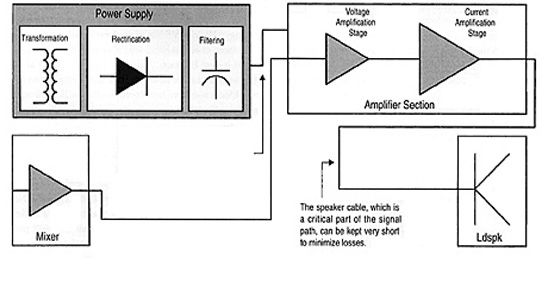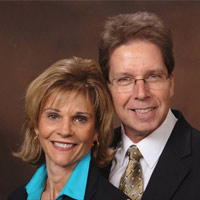By high voltage power distribution, we mean that the output power of the amplifier is converted to a high-voltage/low-current signal for transmission over long distances and/or small wire gauges.
The advantages of the method include low cost and rather “bulletproof” systems.
The downside of the method is that the transformers required present yet another filter for the signal to pass through, often degrading the audio quality.
Since loudspeaker lines should always be kept as short as possible, the ultimate realization of this involves placing the amplifier right at the loudspeaker, connected to it by inches of cable.
This method is best understood by looking at the workings of a traditional power amplifier. There are many shapes and sizes, but they all have some commonalties.
First, all amplifiers take AC power (alternating current) and use it to amplify signals. This requires converting the 60 Hz sinusoidal signal from the power company into something that looks like the audio signal that we wish to amplify.
Several steps are required to accomplish this. First, the voltage component of the power is transformed from 110 or 220 volts (common distribution voltages) into the voltage required by the amplifier circuitry, which is determined by the power rating of the amplifier.
Next, the new value of voltage and current is rectified into DC (direct current). In DC form, the power can be “modulated” by the audio signal voltage to form a higher-power facsimile of the input signal voltage to the amplifier.
This step is accomplished by the output stages of the amplifier. Figure 1 shows the parts of a typical power amplifier.
Conventional systems take the amplified output of the power amplifier and feed it to loudspeakers through a wire gauge of sufficient size to minimize the power loss to 0.5 dB.

When the required wire gauge becomes too large, the power is delivered to the loudspeakers by transforming it into a high voltage/low current signal, more suitable for traveling long distances.
Distributed amplification systems involve separating the parts of the amplifier and distributing them to remote physical locations that, for some applications, better optimize the wiring and interconnects that make a sound system work.
For instance, if the output stage of the amplifier were placed right at the loudspeaker, there would only be a need for a few inches of loudspeaker cable. In order to avoid having to run AC power to all loudspeaker locations, a central DC power supply can be used to drive many amplifier sections.
The central supply can be located near the AC power source, and the DC output coupled to the amplifier sections through appropriate cabling. For large systems, several power supplies can be distributed to keep the distance between them and the loudspeaker/amplifier units at a minimum.
All that remains is to get the electrical signal voltage to all of the “distributed” amplifier/loudspeakers. Since this is a line level signal, it can be run very long distances without significant degradation. Finally, if the DC and signal are run through the same multi-conductor cable, installation of such a system is greatly facilitated.
For electronic systems, DC is an ideal way to power things, since almost every unit in a sound system must convert AC to DC in order to work. In fact, when the AC power standards were established years ago, there were many people, including Thomas Edison, that wanted to use DC distribution. It makes a lot of sense for much of what we use power for.
Advantages:
Short loudspeaker lines
Higher fidelity
Lower operating voltages
Conduit is not required in many locals
Disadvantages:
Increased cost over conventional systems
Upgrades are more complex (This is probably an advantage. Ask anyone who has ever had a customer hang a transformerless loudspeaker on their 70-volt line and load it down).





















